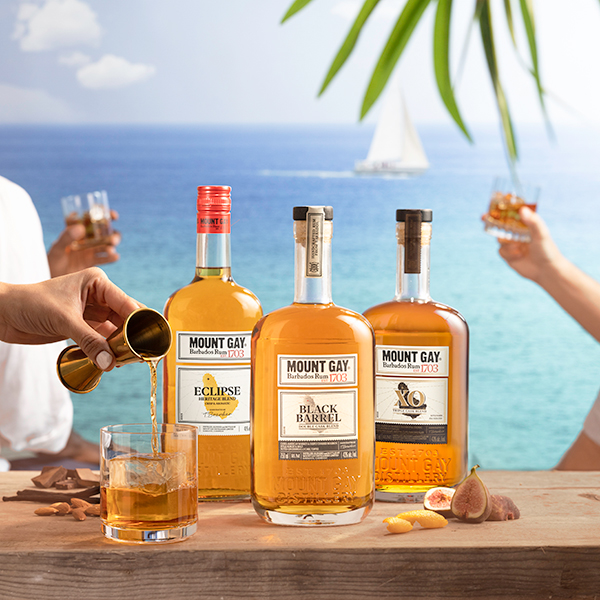For those who didn’t join this summer’s class of newly minted home bartenders, there’s still plenty of time to hone your craft. In fact, fall is arguably the best time of year to start mixing and sipping cocktails. Spirit-forward drinks warm from the inside out, and their high alcohol content guarantees bang for buck — perfect with the holiday season and all its gifting fast approaching.
Assembling a well-stocked, versatile home bar needn’t break the bank, either. Armed with some fresh citrus, ingredients to make basic syrups, and a bottle of all-important Angostura bitters, this list of eight bottles yields more than 25 different cocktails. That’s enough to try two new drinks every week between now and year’s end. So what are you waiting for?
Here are eight essential bottles to build your home bar this fall.
1. LONDON DRY GIN
Gin crops up in countless classic cocktail recipes and has been a focal point for bartenders for years — specifically the London Dry style. G&Ts are perhaps the most well-known gin cocktail but the Martini is the spirit’s true calling. It’s also a surprisingly natural fit for fall. Unlike a Margarita, the Martini is not a cocktail you batch in advance and take to the park — nor can it be fully appreciated sipped from a plastic cup. This drink demands to be savored over time from some fine, well-chilled glassware.
Play around with the proportions of gin and dry vermouth (its other component) and watch the drink’s profile shift significantly. Introduce orange bitters for a citrus-spiced seasoning, and select a garnish fitting your mood: Go for a lemon twist if you’re feeling fresh; an olive or three if you’re salty; or add a cocktail onion (perhaps homemade?) for a miniature meal in a glass when hunger strikes.
All this talk of Martinis should not distract from another great gin-based fall cocktail, the Negroni. Like fall itself, the mix of gin, Campari, and sweet vermouth has one foot each in summer and winter. Sweet citrus notes recall those warmer months, while decadent baking spices cry out for a roaring fire (or a night in front of Netflix, at the very least).
Cocktails:
Recommended Bottles:
Beefeater, Tanqueray, Sipsmith, Highclere Castle
2. PEATED SCOTCH
Not all Scotch is smoky. Only the country’s peated whiskies, which often come from the Scottish island of Islay, carry the distinctive notes of earth and fire. If you don’t know and love that flavor profile, cocktails are an ideal way to become acquainted. Opting for a bottle that’s not overly peated only makes that journey of discovery more accessible (see the suggestions below).
Start with classic cocktails that already contain Scotch. A lightly smoked Hot Toddy will keep you warm and may help fend off pesky colds. For a path less trodden, try the Penicillin, a “modern classic” cocktail made from blended whiskey, ginger syrup, and lemon juice, which is topped with a peated Scotch float. Using a lightly peated Scotch in place of blended whisky keeps things simple, and gets rid of the added float step.
For low-ABV long drinks, turn to the Whisky Highball. Mix Scotch and soda (with a lemon wedge), Scotch and ginger beer (with lime), or even Scotch and cola. The latter’s sweet vanilla and caramel notes help tame the wild whisky. Plus, you’re drinking this at home, so no one will judge.
Last but certainly not least, the Smoky Martini. Once you’ve settled upon your preferred ratio of gin and vermouth, rinse a splash of whisky in an ice-cold coupe, then discard before adding the stirred cocktail. Finish with a plump Castelvetrano olive and enjoy a Martini like no other.
Cocktails:
Hot Toddy, Penicillin, Whisky Highball, Smoky Martini
Recommended Bottles:
Talisker 10, BenRiach 10 Year Old Curiositas, Amrut Fusion
3. BOURBON
Bourbon’s majority-corn mash bill and new-oak aging create a sweet, mellow profile, which is easy-sipping and ideal for mixing cocktails.
Channel your inner Don Draper (or Ryan Gosling) via one of America’s oldest cocktails, the aptly named Old Fashioned. Or, put the shaker tin to good use by whipping up a Whiskey Sour, another timeless classic. Fix up a Gold Rush for a contemporary twist, by shaking 2 ounces bourbon, ¾ ounce fresh lemon juice, and ¾ ounce honey syrup (2 parts honey, 1 part water). The honey syrup boosts the spirit’s richness, while the lemon juice keeps things lively.
While traditionalists opt only for rye, don’t be afraid to use bourbon in a Manhattan. A bottle with a high-rye mashbill (such as Old Grand-Dad Bonded or Four Roses Small Batch) allows you to enjoy the best of both whiskey worlds.
Cocktails:
Old Fashioned, Whiskey Sour, Gold Rush, Manhattan
Recommended Bottles:
Old Grand-Dad Bonded, Four Roses Small Batch, Evan Williams Single Barrel, Woodford Reserve
4. AGED RUM
White rum is as refreshing as any liquor during spring and summer, especially mixed in drinks like the Mojito and Daiquiri. But when the leaves start to fall, it’s the warming richness of dark spirits we crave. Swapping in a fine aged rum as the base spirit in these and almost all classic rum cocktails brings sweet baking spices to the party and toasted oak from the spirit’s time in barrel. Honestly, Piña Coladas have never tasted so good.
Aged rum also takes us on our first steps of Tiki exploration, via the effortless Grog. Shake 2 ounces aged rum with ½ ounce each fresh lime juice and simple syrup (2 parts white sugar, 1 part water), and a few drops of spicy Angostura bitters.
For a weekend cocktail project, prepare a simple oleo saccharum with fresh citrus peel and sugar. The citrusy syrup is the perfect sweetener for an aged rum Old Fashioned, and a few dashes of Angostura bitters will once again liven things up. For a twist on a contemporary classic, fix up an aged rum Gold Rush, swapping in fresh lime juice for the original’s lemon. This riff builds on the richness of the traditional version with added zest and spice.
Cocktails:
Daiquiri, Mojito, Piña Colada, Grog, Old Fashioned, Gold Rush
Recommended Bottles:
Cruzan Estate Single Barrel Rum, Don Pancho Origenes Reserva 8-Year-Old, Ten to One Caribbean Dark Rum
5. BLANCO TEQUILA
With a healthy selection of aged spirits now lining the bar cart, let’s add another white liquor. Even if it is below freezing outside, some occasions call for a lighter, more refreshing cocktail, and tequila is a timeless option. What’s more, the spirit’s vegetal spice will be sure to keep you warm inside.
The most famous tequila cocktail, the Margarita, is evergreen with endless riffs. While the classic recipe requires the additional purchase of orange liqueur, opt instead for agave syrup and a Tommy’s Margarita. Mix instead with grapefruit soda for an even lighter cocktail, the Paloma, or liven up brunch with a Bloody Maria. For an evening sip, and something with a little more body, swap tequila for gin in a Negroni. This only adds to the cocktail’s complexity.
Cocktails:
Tommy’s Margarita, Paloma, Bloody Maria, Negroni
Recommended Bottles:
Arette Blanco, Elvelo Blanco, El Tesoro Blanco, Código 1530 Blanco, Fortaleza Blanco
6. CAMPARI
While there are alternatives out there, Campari is essentially a one-brand category of its own. The bitter red liqueur is synonymous with classic cocktail cousins, the Negroni and Boulevardier, both of which make good use of those newly acquired bottles of gin and bourbon whiskey.
The Old Pal, another well-worn riff on the equal parts formula, mixes bourbon (traditionally rye), Campari, and dry vermouth. Unlike the Negroni and Boulevardier, this cocktail should be served “up” (no ice) with a lemon twist. To dial down the ABV content of Campari cocktails, omit the base spirit altogether. Stir equal parts Campari and sweet vermouth for a classic Milano-Torino, and add a glug of soda for the lighter Americano.
Cocktails:
Negroni, Boulevardier, Old Pal, Milano-Torino, Americano
Recommended Bottles:
Campari
7 & 8. DRY & SWEET VERMOUTH
Vermouth is an aromatic fortified wine. infused with herbs, roots, bark, and flowers, and strengthened by a neutral grape spirit (think: unaged brandy). Dry, or white, vermouth is traditionally associated with France, while sweet (red) vermouth originally hails from Italy.
Essential to many of the cocktails listed above, there are a few points of note on dry and sweet vermouth. The first is that one can’t be substituted for the other because their flavor profiles are so drastically different — though some cocktail recipes may call for both, including the Bronx, a citrusy, stirred Martini riff that mixes 2 ounces gin, ½ ounce each sweet and dry vermouth, and 1 ounce freshly squeezed orange juice.
Secondly, the quality of vermouth cannot be overstated. The aromatized wine is supposed to play the supporting actor to the spirit’s starring role. There’s no point buying a fancy gin or bourbon, therefore, and pairing it with bottom-shelf vermouth. This doesn’t even require spending a fortune — a few extra dollars make a lot of difference in the vermouth department.
Finally, freshness is key. Unlike spirits, vermouth must be stored in the fridge after opening and, ideally, they should be consumed within two months. The good thing is, many liquor stores sell 375-milliliter half-bottles. With keen cocktail exploration, the vermouth bottle will be empty long before its contents deteriorate.
Cocktails:
Martini, Negroni, Manhattan, Bronx
Recommended Brands:
Dolin (dry and sweet), Carpano Antica (sweet), Cocchi (sweet)

